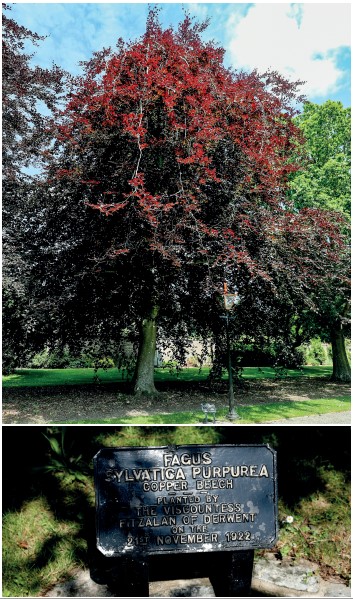THE LASTING LEGACY OF THE LAST VICEROY
Published in Issue 5 (September/October 2021), News, Volume 29By Seán Beattie

Above: A riot of colour—the copper beech tree planted nearly a century ago by Viscountess Fitzalen, wife of Ireland’s last viceroy, on the Queen’s Walk of the Viceregal Lodge, now Áras an Uachtaráin.
As summer turns to autumn, the trees in our parks and gardens still retain their beauty, bringing bright and glorious colours into our lives, whatever level of lockdown we have had to endure. In the sheltered environs of the Phoenix Park, the walled gardens of Áras an Uachtaráin enclose some of the most attractive treescapes in the land. One notable avenue, the Queen’s Walk, boasts a number of fine specimens, each with its own story to tell, such as the copper beech planted by the wife of the last viceroy of Ireland.
The viceroy, or the lord lieutenant, was the monarch’s representative in Ireland. The citizens of Dublin traditionally had a bitter-sweet relationship with the aristocracy, and all the pomp and ceremony of their class. For an insight into this relationship we turn to the pages of Ulysses. Joyce depicts the ‘other-world’ passage of the viceregal cavalcade through Dublin. The viceroy was a real-life English aristocrat, William Humble Ward, Earl of Dudley. In the ‘Wandering Rocks’ episode, Dudley departs the Viceregal Lodge and ‘he passed Kingsbridge travelling along the north quays’.
As the viceroy makes his way through the city, a cross-section of the citizens respond, some merely curious, others respectful and some downright hostile. We encounter John Wyse Nolan, who smiles ‘with unseen coldness’ at the sight of the lord lieutenant and governor-general of Ireland. The viceroy’s carriage was pulled by a pair of ‘glossy horses’, their harness rattling thanks to the cobblestones of the metropolis. The destination was the opening of the Mirus Bazaar to raise funds for Mercer’s Hospital—a typical event in the lives of the Dudleys, who, to be fair, did much charitable work. As the pompous cavalcade rattled through the streets in Joyce’s Dublin of 1904, few could have anticipated that the days of the viceroy were numbered.
Seventeen years later, change was in the air. Viscount Fitzalan of Derwent took up his post in the Phoenix Park. Tongue in cheek, Prime Minister Lloyd George wished the new viceroy well, hoping that he would have a ‘nice, tranquil time’ once he exited London.
Lloyd George believed that he had pulled off a masterstroke by appointing a Catholic viceroy, the first in modern times and the leading Catholic aristocrat in England. Others were not so impressed. Cardinal Logue, primate of all Ireland, responded tersely that he would rather see a Catholic hangman! Undaunted, Fitzalan did not hide his religion and was regularly seen in the congregation of the Pro-Cathedral. He had a special affection for John Henry Newman, and University College chapel on St Stephen’s Green, associated with Newman, was where he felt spiritually at home.
On 21 May 1921, as the War of Independence raged, Fitzalan was sworn in as lord lieutenant in a scaled-down investiture in Dublin Castle. It could be described as a ‘socially distanced’ event but some of the centuries-old emblems and symbols of ceremonial remained unchanged. In full regalia, he approached the dais in the council chamber of Dublin Castle to receive the sword of state and a warrant of office. He was also invested with the Golden Collar and Insignia of the Most Illustrious Order of St Patrick. Two months later the prime minister’s words seemed prophetic, as a truce was called, marking the end of the War of Independence.
Fitzalan got on with his official duties. In June he attended the first meeting of the parliament of Northern Ireland in City Hall, Belfast. In August it was the RDS Horse Show. There was time, too, for the summer soirées in the grounds of the Viceregal Lodge.
The wheels of power turned slowly, almost imperceptibly. Fitzalan welcomed the Treaty, which was signed in December 1921, but remained in office for another year. Later, he handed over power to Michael Collins and the Provisional Government and signed a declaration officially dissolving the parliament of Southern Ireland. Fitzalan had served a very short term in office and was warmly welcomed back to London, where he was rewarded with the Order of the Garter.
In the history books Fitzalan’s name is rarely mentioned, apart from his being the last viceroy of Ireland, but there is one place where his memory is firmly rooted. Before he returned home, his wife performed a final ceremonial act—planting a copper beech tree on the Queen’s Walk. Almost a century later, the copper beech blossoms annually, a deep purple in midsummer, a coppery red in autumn, a glorious riot of colour, a living memorial of a bygone era.
Seán Beattie is editor of the Donegal Annual and chair of the Ulster Local History Trust.
















